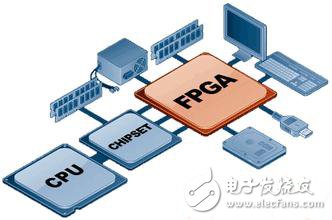Generally speaking, "one hero is three gangs", a single embedded system is used by a single FPGA. It is usually done by a combination of multiple devices, such as an FPGA+CPU. Usually an FPGA+ARM, ARM is responsible for software configuration management, interface input peripheral operations, etc. The FPGA is responsible for large data volume operations, which can be used as a dedicated coprocessor for the CPU, and is often used to extend the external interface. Commonly used are ARM+FPGA, DSP+FPGA, or network processor+FPGA and other architectural forms, which form the processing form of the entire high-speed embedded device.
It must be said that with the advancement of technology, the integrated units in the CPU are now increasing. For example, the processor inside TI's "Da Vinci" architecture is usually composed of ARM+DSP. At the same time, the heterogeneous processor form is gradually becoming popular, such as the structure of ARM9+ARM7. The design of such a main processing system (ARM9) external auxiliary processing system (ARM7) has also become the popular direction of current processor design. The main processing system runs the embedded operating system, while the auxiliary processing unit focuses on the processing of some specialized areas. The application of these systems reduces the field of FPGAs as CPU coprocessing units. Because after all, FPGAs are relatively expensive compared to popular embedded processors such as ARM.

In this case, FPGA vendors seem to feel the pressure, and unanimously launched FPGAs with ARM hard core, such as ALTERA's and XILINX's ZYNQ and ALTERA's SOC FPGA. This is the need to compete with each other, and it is also a masterpiece of many CPU manufacturers. Even with these two trends, the classic processor + FPGA design can still be seen as a typical configuration for high-performance embedded systems.
The classic processor + FPGA configuration has a variety of architectural forms, that is, multiple processor units, which may be ARM, MIPS, or DSP. The FPGA may also be a multi-chip configuration, and the specific architectural form is related to the specific processing of the service. It is also related to the positioning of the target device. Because FPGA as a simple business flow large data volume processing form is still an unparalleled advantage of the CPU, FPGA can develop a large number of business data parallel, thus achieving high-speed data processing.
In terms of high-speed processing, another development trend of CPU is multi-core. Multi-core processors can also handle the parallelism of large data services. For example, the industry TERILA has launched a 64-core multi-core processor, using MIPS processors, through two-dimensional MASH. The networks are connected together to form the structure of the NOC. The performance has been comparable to the processing power of existing high-speed FPGAs. However, the problem that multi-core processors have to say is that after the same service flow is allocated to multi-core processing, if interaction is required, such as accessing the same resource, the problem of consistent reading and writing cache will be solved, and the natural idea of ​​solving this problem will be solved. It is a lock, that is, a spin lock is added to the variable access, but the problem is a sharp drop in processing performance. FPGAs, regardless of parallel processing and access to the same variable, can become engineers' design level problems without a principle challenge.
Several popular applications of FPGA
No device can meet the needs of all human beings, so don't worry about FPGAs being useless. Must be a combination of products. The following mainly introduces FPGAs as several applications for today's hot scenes.
(1) Network storage products, especially on current NAS or SAN devices, require high storage time, interface, security, etc., and FPGAs have the ability to process performance or extend interfaces. Great work. Now high-end FPGAs can extend 32 or more 4G or 8G FC interfaces. And its protocol processing is relatively fixed, which also makes FPGAs have a large number of possible applications in this field.
(2) High-speed network equipment, now high-speed network equipment 10G, 40/100G Ethernet equipment field, the same FPGA is also a key processing component. In particular, the commercialization of IPv6 and the high requirements of big data for infrastructure have made processing applications in this field more and more extensive. This field is usually a typical architecture of high-speed network processor (NP) + FPGA.
(3) Communication equipment such as 4G, for the signal processing of the new generation communication base station, the architecture of the FPGA+DSP array is a perfect match. Especially before the introduction of dedicated processing chips, such an architecture can ensure the rapid development and deployment of a new generation of communication infrastructure.
There is no perfect architecture, only the right combination, all kinds of chips and architectures are for application services, and mutual penetration is a trend, and it is inevitable. The programmable area of ​​FPGA versus processor is still niche (although the number is quite large). But as a joke said: Although the thigh is thicker than the roots, it is never important. This is a joke. The implementation of the FPGA leaves a lot of possibilities and imagination for the future chipization, so that the chip can be used to greatly reduce the cost when a large number of bursts are applied, which is unmatched by other programmable devices.
SDEC 401-999KW Diesel Generator
Perkins 401-999Kw Diesel Generator,Perkins Shanghai Genset,Perkins Shanghai Power Generator,401-999Kw Diesel Generator
Shanghai Kosta Electric Co., Ltd. , https://www.kostagenerators.com